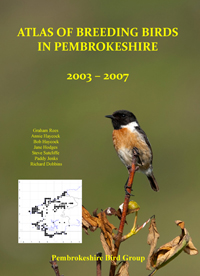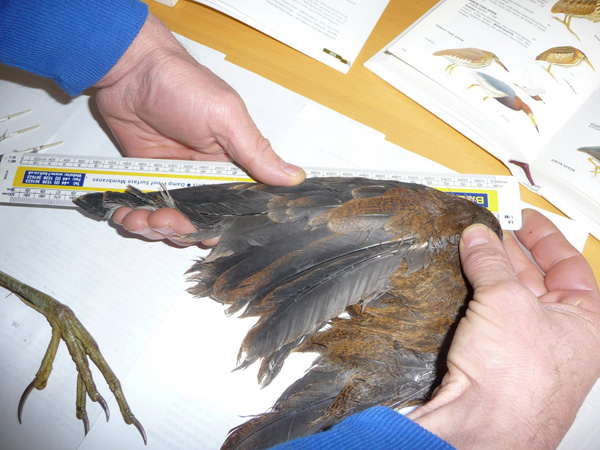Anas rubripes
The afternoon of Sunday 16th March was one of those 'toss a coin in your head' afternoons. I'd been out cycling for four hours in the morning (honestly, I had), and after cleaning the bike, taking a shower, and demolishing a sizeable lunch, I was pretty tired. It was a choice between going for a snooze, or heading down to Dale, as I tend to on a Sunday afternoon, to check the gull roost.
My better half, Ellie, was up for taking our dogs for a good walk, so I dragged myself out to the car and we headed off for Dale from our home in Haverfordwest (just 600m from the Rose-coloured Starling and did it visit our garden? Nope!). For some reason I suggested we went to Marloes Mere first, which would be my first visit of the year, so that I could check the Mere and surrounding fields while Ellie and her mum took the dogs down to the beach. We'd still have time for the gull roost afterwards, which would give me a chance to see if the first-winter ring-billed gull was still around, and what the count of Mediterranean gulls would be (the previous Sunday it had been an impressive 17).
After checking the north-east portion of the Mere from the northern Scammell hide, which revealed my first wheatear of the year as well as feral snow goose, I dragged my weary carcass back through the car park and out to the southern Britton Hide, built in memory of my good friend Mark. As everyone knows the original hide had blown down in the severe storms of December 2006, but a sponsored bike ride from Marloes Mere to the Welsh Wildlife Centre in Cilgerran during Easter 2007 had raised the funds to rebuild it. Whilst it still needed some finishing off at the time, it still provided shelter from the elements and some cover for viewing the southern and western end of the Mere (I think some Birdforum comments that it looked a shed were justified at the time, but not now!)
With the scope set up I quickly locked on to a darkish-looking female-type mallard, dip-feeding on the largest open area of water viewable from the hide. It was with a drake mallard, but alarm bells were ringing immediately due to the consistent chocolate-brown body and wing feathers, contrasting somewhat with paler cheeks, neck and supercilium. There were no paler centres to the body feathers, particularly the flanks, and there was no white visible on the sides of the tail. I couldn't make out anything on the closed wing, and the bird frustratingly did not flap or open its wings at all to show me the all-important speculum.
I rang Jon Green from the hide (I just knew he'd be in, he doesn't get out much you know) who very helpfully double-checked literature for me, and then Richard Dobbins who was unfortunately too far away at Llys-y-fran to make it to Marloes before dark. He did get hold of Steve and Anna Sutcliffe (whose number I didn't have to hand), who live just a few miles away, who checked their coy of BWP and then joined me for the last 20 minutes or so of light. Sadly the bird continued to feed the whole time, and as the light faded we still hadn't seen the all-important speculum.
I had a good vibe about the bird though, and in the past instinct has tended to prevail (eg black scoter, Isabelline wheatear, semi-palmated sandpiper), so on returning home and after checking literature for myself (as well as blogging my poor attempt at a 'phone-'scope photo), I decided to circulate the news as a probable black duck. From the plumage pattern and tone alone, I couldn't see how it could be a hybrid, which had been my one main concern. The fact that no white trailing edge to the speculum/secondaries could be seen at rest also boded well.
Thankfully the bird showed well the next morning, including revealing the clinching purple-blue speculum with black leading and trailing edge - not a trace of white! Other good features were the white under-wing feathers contrasting markedly with the flanks, and the detailed pattern of the olive-toned bill with dark basal two-thirds of the culmen and nail, with an olive 'wrap' across the distal third. All of the female mallards present had quite different orange-toned bills - and they weren't chocolate brown either!
The Marloes Mere black duck was only the third for Wales, following the famous male at Aber, Caernarfon from 1979 to 1985, which produced several hybrid young, and our only previous county record, a male at Heathfield in January and March 2001, which was sadly only seen by two observers. Thus for many, this bird provided a new Pembrokeshire bird for the list, a Welsh tick, for some a 'lifer' and for me justification for my persistence with the under-watched peninsular (mind you, can name a part of Pembrokeshire that could be considered to be well-watched?).
The bird remained well into May, usually paired to a drake mallard, until the vegetation grew so high that most of the ducks 'disappeared'. Whether she stayed to breed will never be known, though certainly no dubious-looking black duck look-alike youngsters were ever seen and by the time the vegetation died back, neither was the black duck. Where did she go?
For obvious reasons, I dedicate 'my' black duck to Mark Britton, who remains sadly missed. His hide continues to be a real asset to us - seven months after the black duck was found from it, a lucky lucky lucky visitor found blackpoll warbler in the willows in front of it - and at the time he was watching it, I was less than a mile in a straight line away on Dale Airfield! Birding can be cruel sometimes. Black duck, blackpoll warbler, what black next . . . .?
David Astins
Pembrokeshire Bird Report 2008
 Sunday, February 9, 2014 at 9:35AM
Sunday, February 9, 2014 at 9:35AM  Pembrokeshire Avifauna committee | Comments Off |
Pembrokeshire Avifauna committee | Comments Off |  BBRC in
BBRC in  Lesser Yellowlegs
Lesser Yellowlegs 



